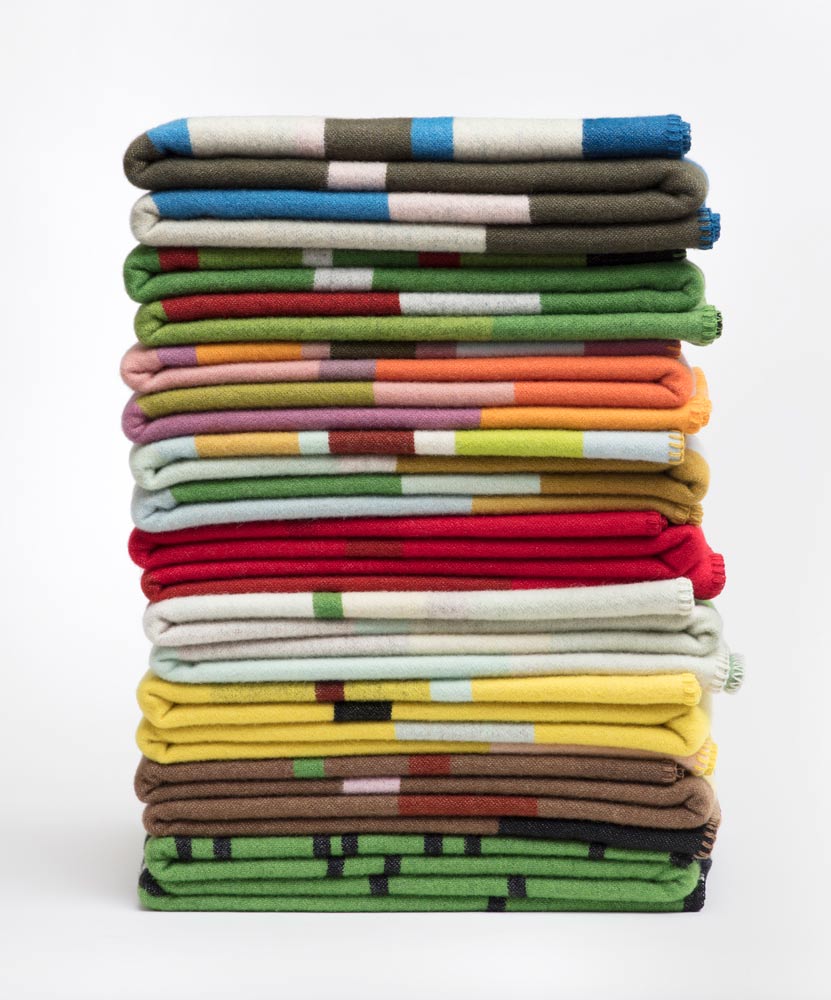History & background
”It is now many years since my mother and I cycled south along Hærvejen – from Viborg to the German border. It was 1972, I was 11, and this was my introduction to Mid-Jutland. Today, I see that this was a journey that entered my consciousness and became, in time, a form of longing. Now, I feel at home here. All my adult life, I have lived right on the edge of the “real” Mid-Jutland, in Silkeborg and Gl. Rye, a stone’s throw from Jutland’s high watershed and the heathland.”
Midtjyske Tæpper is the story of four places in Mid-Jutland, a story that is told through the creation of nine rugs.
It is a project where I wanted to make visible, unite and convey four locations, my design process, craftsmanship, and production in a series of machine woven rugs.
The idea originates from my connection with Mid-Jutland, the love of my field – I am a weaver – as well as the fact that the very last production facilities within my field are about to disappear completely!
For many years, I have felt like putting into production a series of rugs in a quite heavy, fulled quality reminiscent of the Swedish “filtar” (rugs) from the ‘50s.
Rugs that become more beautiful with time, that are durable and that can be passed on to the next generation.

Foto: Ole Akhøj

I have four old blankets at home, one borrowed, one bought, one inherited, and one stolen…

I hope Midtjyske Tæpper become part of that family.
The rugs are accompanied by a book that describes the process and production of the individual rugs and tells the story of the four locations in Mid-Jutland:
- Klostermølle / large heritage-listed wooden building near Mossø.
- Tinnet Krat / the source of Gudenå Stream.
- Skovvilla / Anton Rosen’s building from 1885 for the then Silkeborg Spa.
- The Bathhouse in Silkeborg / A public bath for citizens of the town erected in 1920.

History & background

”It is now many years since my mother and I cycled south along Hærvejen – from Viborg to the German border.
It was 1972, I was 11, and this was my introduction to Mid-Jutland. Today, I see that this was a journey that entered my consciousness and became, in time, a form of longing.
Now, I feel at home here.
All my adult life, I have lived right on the edge of the “real” Mid-Jutland, in Silkeborg and Gl. Rye, a stone’s throw from Jutland’s high watershed and the heathland.”
Midtjyske Tæpper is the story of four places in Mid-Jutland, a story that is told through the creation of nine rugs.

It is a project where I wanted to make visible, unite and convey four locations, my design process, craftsmanship, and production in a series of machine woven rugs.
The idea originates from my connection with Mid-Jutland, the love of my field – I am a weaver – as well as the fact that the very last production facilities within my field are about to disappear completely!
For many years, I have felt like putting into production a series of rugs in a quite heavy, fulled quality reminiscent of the Swedish “filtar” (rugs) from the ‘50s.
Rugs that become more beautiful with time, that are durable and that can be passed on to the next generation.

I have four old blankets at home, one borrowed, one bought, one inherited, and one stolen…

The rugs are accompanied by a book that describes the process and production of the individual rugs and tells the story of the four locations in Mid-Jutland:

Klostermølle / large heritage-listed wooden building near Mossø.

Tinnet Krat / the source of Gudenå Stream.

Skovvilla / Anton Rosen’s building from 1885 for the then Silkeborg Spa.

The Bathhouse in Silkeborg / A public bath for citizens of the town erected in 1920.
I have asked a number of people to write something, people who each have a connection with one of the four places, with the craft or with textile production – and who have something to say:
Anders Laugesen, Arne Høi, Iben From, Nicolai de Gier, Kristine Holm-Jensen, and Lis Thavlov have contributed texts to this book.
The book is 132 pages and richly illustrated with photos by Ole Akhøj.
